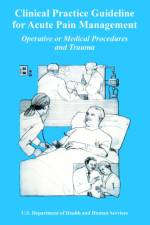- Operative or Medical Procedures and Trauma
av Human Service & Us Department of Health
241
Approximately 23.3 million operations were performed in 1989 in the United States, and most of these involved some form of pain management. Unfortunately, clinical surveys continue to indicate that routine orders for intramuscular injections of opioid "as needed"-the standard practice in many clinical settings-fail to relieve pain in about half of postoperative patients. Postoperative pain contributes to patient discomfort, longer recovery periods, and greater use of scarce health care resources and may compromise patient outcomes. There is wide variation in the methods used to manage postoperative and other acute pain, ranging from no set strategy to a comprehensive team approach as advocated in this clinical practice guideline. This guideline sets forth procedures to minimize the incidence and severity of acute pain after surgical and medical procedures and pain associated with trauma in adults and children. It offers clinicians a coherent yet flexible approach to pain assessment and management for use in daily practice. Although it is not practical or desirable to eliminate all postoperative and other acute pain, an aggressive approach to pain assessment and management can reduce such pain, increase patient comfort and satisfaction, and in some cases, contribute to improved patient outcomes and shorter hospital stays. This clinical practice guideline was developed under the sponsorship of the Agency for Health Care Policy and Research (AHCPR), Public Health Service, U.S. Department of Health and Human Services. To develop the guideline, AHCPR convened an interdisciplinary expert panel made up of physicians, nurses, a pharmacist, a psychologist, a physical therapist, a patient/consumer, and an ethicist. The panel first undertook an extensive and interdisciplinary clinical review of current needs, therapeutic practices and principles, and emerging technologies for pain assessment and management. Second, the panel conducted a comprehensive review of the field to define the existing knowledge base and critically evaluate the assumptions and common wisdom in the field. Third, the panel initiated peer review of guideline drafts and field review with intended users in clinical sites. Comments from these reviews were assessed and used in developing the guideline.

